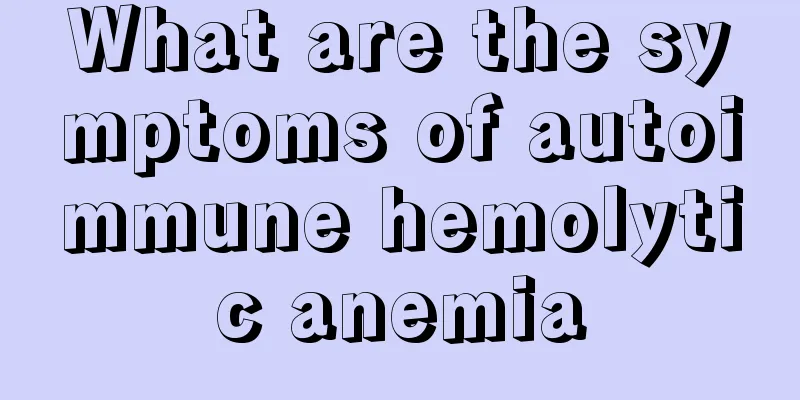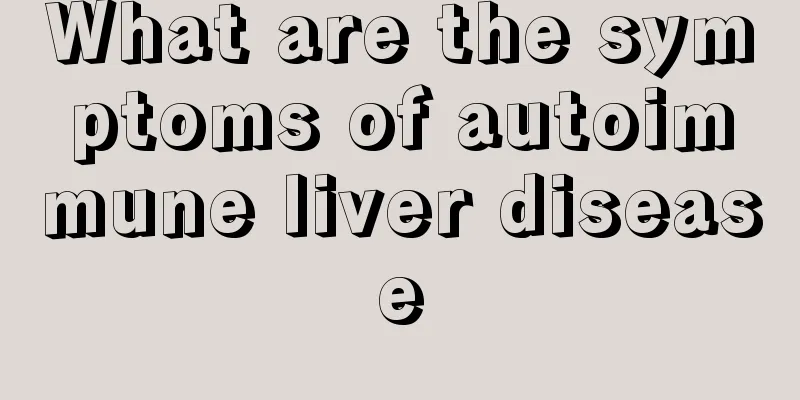What are the symptoms of autoimmune hemolytic anemia

|
Autoimmune hemolytic anemia is caused by a disorder in the patient's immune function, which causes the body's antibodies to attach to the surface of red blood cells, leading to more severe anemia in the patient. The patient often becomes pale and weak. For patients in the acute stage, it often causes symptoms such as nausea and vomiting, persistent high fever, abdominal pain and diarrhea, which are particularly harmful to the patient. (I) Warm antibody type The main symptoms are paroxysmal pale complexion, weakness, hemoglobinuria (soy sauce color, wine color or strong tea color), often accompanied by jaundice and hepatosplenomegaly, with splenomegaly being the main symptom. Generally, it is divided into two types according to the severity of the disease: 1. The acute type usually occurs in infants under 3 years old, with male children being the majority. There is a history of prodromal infection, especially viral infection, 1-2 weeks before the onset of the disease. The onset is acute, with fever, chills, vomiting, abdominal pain, progressive anemia, jaundice, splenomegaly, and often bloody proteinuria. In severe cases, acute renal failure may occur. A small number of patients have thrombocytopenia. Skin hemorrhage occurs, which is called EVS syndrome. The clinical course of acute patients is self-limited, and hemolysis stops on its own 1-2 weeks after onset. About 50% of patients recover within 3 months. Patients with Evans syndrome may die from bleeding. 2. The chronic type is more common in older children, and primary cases account for the majority. The onset is slow and may present as progressive or intermittent hemolysis. The main clinical manifestations are anemia, jaundice, hepatosplenomegaly, often accompanied by bloody proteinuria. The clinical course is chronic. Repeated infections aggravate hemolysis, anemia and jaundice. Chronic type of illness usually lasts more than 3 months. Primary cases can last for 10 to 20 years, and patients with Evans syndrome often have worse symptoms afterward. If there are repeated secondary infections or combined immunodeficiency diseases, the mortality rate is 11%-36%. (II) Cold antibody type 1. Cold agglutinin disease is more common in children under 5 years old. It is often secondary to infectious mononucleosis, cytomegalovirus infection, mycoplasma pneumonia, etc. The onset is acute, with the main symptoms being flare-ups at the ears, nose tip, fingers, and toes after being exposed to cold, and Raynaud's sign disappearing as the environment warms. The clinical course is self-limited. There may be varying degrees of jaundice and anemia, which will disappear as the primary acne heals. 2. Paroxysmal cold hemoglobinuria can occur in children after one year old, and there are also primary patients. The disease develops suddenly after being exposed to cold, with prominent symptoms including fever, chills, abdominal pain, back pain, anemia and hemoglobinuria. Most of the symptoms will be relieved within a few hours, but may recur after being exposed to cold. The above is an introduction to the clinical symptoms of autoimmune hemolytic anemia. I believe that through the above introduction, you have a deeper understanding of autoimmune hemolytic anemia. I hope that the above content can be helpful to you. Finally, I wish you good health! |
<<: What are the symptoms and hazards of dust mite allergic rhinitis?
>>: If you have brown round spots, scientific treatment is very important
Recommend
The person next to you snores loudly. Here are 7 tips to help you fall asleep
According to the Popular Health Network, there ar...
Three methods for early diagnosis of prostate cancer
Early detection and early treatment are the key t...
What are the factors that affect the life expectancy of patients with colorectal cancer?
Having cancer does not mean the end of life. In l...
Symptoms of brain cancer that are easily overlooked in life
Brain cancer is a central nervous system tumor wi...
The difference between fever and heat stroke
If people are exposed to heat waves in a high-tem...
Do I need calcium supplements if I exercise regularly?
Everyone knows the importance of calcium suppleme...
What can be seen during anterior rhinoscopy
Anterior rhinoscopy is also a method often used i...
What are the causes of brain cancer?
Brain cancer refers to a malignant tumor that occ...
Why does my child blink frequently?
If a child blinks frequently in daily life, paren...
What are the methods to reduce fever caused by indigestion?
It is very common for children to have food accum...
How long is the best time to soak your feet in vinegar
It is usually sufficient to soak your feet in vin...
Can iodine tincture treat folliculitis?
When people mention folliculitis, the first thing...
What are the symptoms of liver cancer? Liver cancer often has these symptoms
Fever: Liver cancer is prone to cancer fever, whi...
What medicine can remove chloasma
When women reach middle age, one of the problems ...
What are the advantages of pixel laser acne scar removal surgery
If there are acne scars on the face, it will dama...









